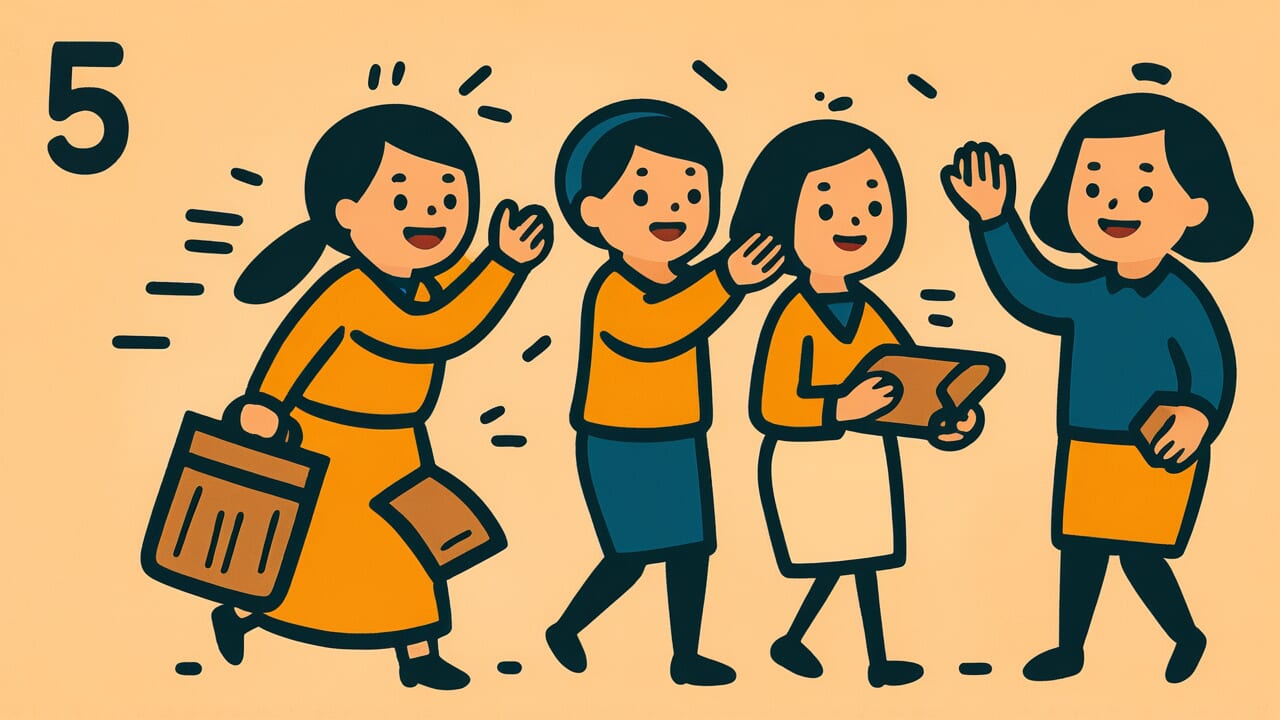How to Read “First luck, second hips, third rhythm”
Ichi-un-ni-koshi-san-byōshi
Meaning of “First luck, second hips, third rhythm”
This proverb lists the elements needed for success in arts and work, ranked by importance. First comes “luck,” meaning good timing and favorable circumstances. No matter how hard you work, you won’t succeed without the right era or environment.
Second is “hips,” which means perseverance and the ability to maintain proper posture. Even with good luck, you need persistence to make success last. Third is “rhythm,” which refers to timing and pace when doing things.
People use this proverb when they want to accept that effort alone doesn’t guarantee success. At the same time, it encourages focusing on what you can control.
Today, recognizing the role of luck relieves excessive pressure. It also clarifies what parts require your effort. This creates a balanced view of life.
Origin and Etymology
The exact origin of this proverb isn’t clearly documented. However, the structure of the phrase offers interesting insights.
“First luck, second hips, third rhythm” uses a uniquely Japanese way of ranking success factors. Similar expressions include “first a daughter, second a son” and “first Mount Fuji, second a hawk, third an eggplant.”
These numbered sayings are easy to remember. They also clearly show priorities. This was a practical way to pass down wisdom.
The choice of “hips” is especially noteworthy. In Japanese traditional arts and martial arts, hip positioning is fundamental. In Noh theater, tea ceremony, and kendo, you start by settling your hips.
Here, “hips” doesn’t just mean a body part. It symbolizes perseverance, patience, and the spirit to maintain proper posture.
“Rhythm” is also an important concept in Japanese arts. It applies not only to music and dance but also to how you approach work. It refers to timing, pace, and sense of rhythm.
This word resonates deeply with Japanese sensibility.
This proverb probably originated in the world of traditional arts. Later, it became widely used as life advice.
Usage Examples
- He had talent, but as they say, “First luck, second hips, third rhythm”—being born in the right era made a big difference
- My teacher taught me that “First luck, second hips, third rhythm” means even without luck, you must settle in and keep going
Universal Wisdom
The proverb “First luck, second hips, third rhythm” contains deep wisdom learned throughout human history. It warns against believing effort solves everything. At the same time, it prevents falling into fatalism.
When people see someone successful, they tend to focus only on that person’s effort. But our ancestors saw many people who worked hard but weren’t rewarded. The era was wrong, the place was wrong, the connections weren’t there.
By placing “luck” first, this proverb shows kindness to those who didn’t succeed. It wasn’t your fault—you just didn’t have luck.
However, the proverb doesn’t stop at luck. By placing “hips” second, it shows there are things humans can do. You can’t choose your luck, but you can choose to work persistently.
You can maintain proper posture through your own will.
Then comes “rhythm” in third place. This isn’t just technique—it’s sensitivity to reading the flow. Even with good luck and persistent effort, you won’t get results if your timing is off.
This ranking shows deep understanding of human nature. Acknowledge what you can’t control, focus on what you can control, and refine your sensitivity.
This three-layer structure is why the proverb continues to resonate across generations.
When AI Hears This
From a control engineering perspective, this proverb contains a surprisingly precise control system design philosophy.
First, “luck” corresponds to initial conditions and disturbances. Control theory shows that system performance heavily depends on initial state. In rocket launches, a 0.1-degree angle error becomes a fatal deviation thousands of kilometers away.
Placing luck—an uncontrollable element—first shows extremely accurate recognition as a system designer.
Next, “hips” means stability of the controlled object. In control engineering, natural frequency and damping coefficient matter. In the human body, the hips play exactly this role.
Stable hips absorb external forces and quickly restore posture. This is a self-stabilizing mechanism through negative feedback.
“Rhythm” is the feedback cycle. Control theory has the Nyquist frequency concept. Without proper sampling periods, control becomes unstable.
Rhythm in martial arts works the same way—too fast and you miss, too slow and you can’t respond.
Martial artists in the Edo period accurately verbalized the three elements of optimal control without using formulas.
Lessons for Today
This proverb teaches modern people about “balancing acceptance and effort” in life.
Modern society overflows with messages saying “effort always pays off.” But this sometimes corners people. When things don’t work out, they blame themselves for not trying hard enough.
This proverb frees you from excessive self-blame by first acknowledging luck’s existence.
At the same time, it doesn’t let you fall into fatalism. You can’t choose your luck, but you can settle in and work steadily. Focus on what you can do today.
Maintain proper posture. This becomes the foundation supporting your life.
And cultivate sensitivity to read the flow and calculate timing. This only grows through daily experience.
What matters is not becoming bitter when luck doesn’t favor you. And being prepared to use luck when it comes. Results depend on luck, but the process is yours.
Settle in, work at your own pace, and tackle what you can do now. This accumulation becomes the power that makes you shine when luck finally comes your way.



Comments